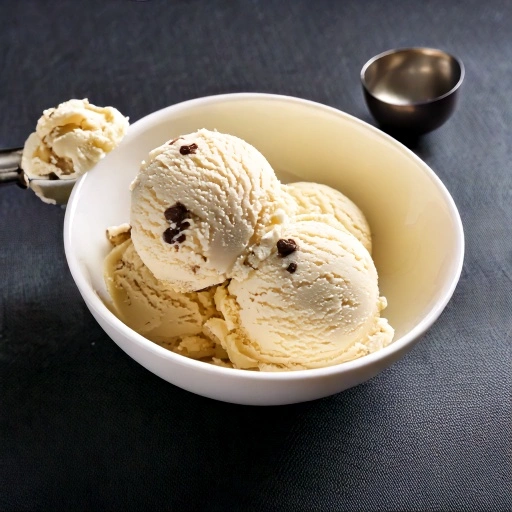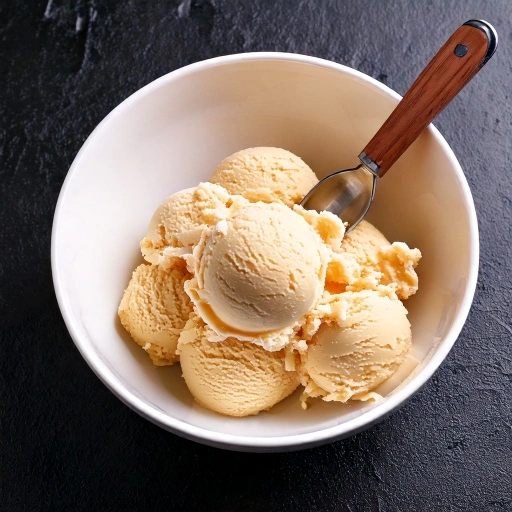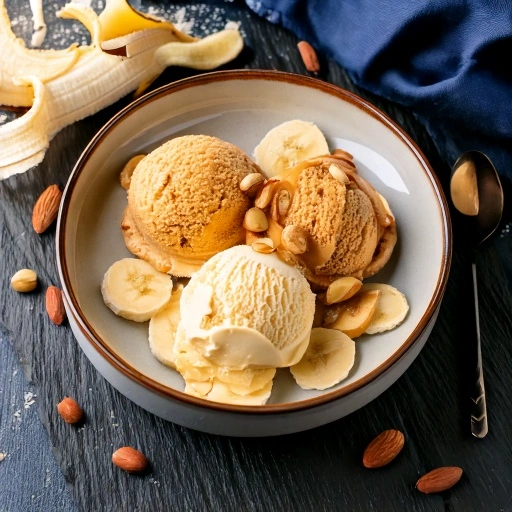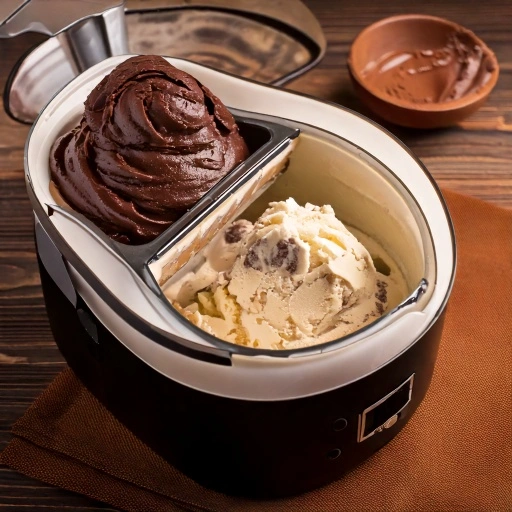Table of Contents
Have you ever noticed how your furry companion longingly stares at you while you enjoy a cold scoop of ice cream on a hot summer day? Those puppy eyes are hard to resist! Creating a dog ice cream recipe at home is not only a fun activity but also ensures your canine friend can safely indulge in this cool treat without harmful ingredients. Unlike commercial ice creams that contain sugar, chocolate, and artificial sweeteners like xylitol (which are toxic to dogs), homemade dog ice cream recipes can be nutritious, refreshing, and specifically tailored to your pet’s preferences and dietary needs. Let’s dive into creating a delicious frozen treat that will have your dog’s tail wagging with excitement!

Ingredients List
Creating the perfect dog ice cream requires simple, dog-safe ingredients that you likely already have in your pantry. Here’s what you’ll need for our basic recipe:
- 2 cups plain, unsweetened yogurt (preferably Greek yogurt for extra protein)
- 1 ripe banana (provides natural sweetness and creamy texture)
- 2 tablespoons smooth, unsalted peanut butter (check that it doesn’t contain xylitol)
- 1 tablespoon honey (optional, for extra sweetness)
- 2-3 tablespoons pure pumpkin puree (make sure it’s 100% pumpkin without additives)
Possible Substitutions:
- For dairy-sensitive dogs: Replace yogurt with unsweetened coconut milk or coconut cream
- Banana alternatives: ½ cup mashed sweet potato or applesauce
- Peanut butter alternatives: Almond butter or sunflower seed butter (always check for dog-safe ingredients)
- Instead of honey: A small amount of pureed berries can add natural sweetness
The rich, creamy texture of Greek yogurt combined with the sweet aroma of ripe banana creates a base that will have your dog eagerly waiting by the freezer!

Timing
Preparation Time: 10 minutes Freezing Time: 4-6 hours (or overnight for best results) Total Time: 4 hours 10 minutes (minimum)
Compared to traditional ice cream that requires cooking custard bases and extensive churning (typically taking up to 2 hours of active preparation), this dog ice cream recipe saves approximately 75% of active preparation time. The hands-on component takes just minutes, making it possible to prepare this treat while doing other kitchen tasks.
Step-by-Step Instructions
Step 1: Prepare Your Ingredients
Gather all your ingredients and ensure they’re at room temperature for easier blending. Room temperature ingredients combine more smoothly, preventing ice crystals that could make the texture less appealing for your pup. If your banana isn’t quite ripe enough, microwave it for 10-15 seconds to soften it.
Step 2: Blend The Base
Combine the yogurt, banana, and peanut butter in a blender or food processor. If you don’t have either appliance, don’t worry! You can use a bowl and whisk, though it will require more effort. Process the mixture until everything is thoroughly incorporated and the consistency is silky and uniform throughout.
Step 3: Add Optional Ingredients
Now’s the time to fold in any additional flavor enhancers like pumpkin puree or honey. For dogs with specific preferences, consider what your particular pup loves most. Does your dog go crazy for blueberries? Add a handful! Is pumpkin their favorite? Double the amount in the recipe. This personalization makes the treat extra special.
Step 4: Pour Into Molds
Transfer the mixture into silicone ice cube trays, small paper cups, or specialized dog treat molds. Pro tip: If using paper cups, insert a dog biscuit halfway into each cup to create a built-in “popsicle stick” that your dog can hold onto while enjoying their treat. Fill each compartment about ¾ full to allow for slight expansion during freezing.
Step 5: Freeze Until Solid
Place the filled molds in the freezer on a level surface. For faster freezing, place them toward the back of the freezer where temperatures are typically colder. Let the mixture solidify completely in the freezer, which generally requires several hours, or preferably overnight for the best texture and consistency.
Step 6: Serve And Store
Once frozen solid, remove the dog ice cream treats from their molds. If they’re sticking, run the bottom of the mold under warm water for a few seconds to loosen. Serve one treat to your eager pup and store the rest in an airtight container in the freezer for future enjoyment.

Nutritional Information
Understanding the nutritional content of your dog ice cream recipe helps ensure it fits appropriately into your pet’s diet. Based on our basic recipe (using Greek yogurt), each 1/4 cup serving contains approximately:
- Calories: 75-85 kcal
- Protein: 3.5g
- Fat: 4g
- Carbohydrates: 6g
- Calcium: 50mg
- Potassium: 120mg
Nutritional Benefits:
- Greek yogurt provides probiotics for digestive health
- Banana offers potassium and vitamin B6
- Peanut butter adds healthy fats and protein
- Pumpkin puree contains fiber for digestive regularity
This dog ice cream constitutes approximately 5-8% of a medium-sized dog’s daily caloric needs, making it an appropriate occasional treat rather than a meal replacement.
Healthier Alternatives for the Recipe
Even a healthy dog ice cream recipe can be further optimized to meet specific dietary goals or restrictions:
Lower Calorie Version:
- Replace full-fat yogurt with non-fat Greek yogurt (saves approximately 30 calories per serving)
- Use half the amount of peanut butter and add an extra tablespoon of pumpkin
Protein-Boosted Version:
- Add 1 tablespoon of unflavored whey protein powder suitable for dogs
- Mix in 1 tablespoon of cottage cheese for additional protein without significant calorie increase
Sensitive Stomach Formula:
- Substitute regular yogurt with probiotic-rich kefir
- Add 1 teaspoon of ground ginger, known to aid digestion
- Increase pumpkin to 1/3 cup for added fiber
Joint Health Support:
- Add 1/2 teaspoon of dog-safe bone broth powder
- Include 1 teaspoon of ground flaxseed for omega-3 fatty acids
Remember to introduce any new ingredients gradually and monitor your dog for any signs of digestive upset or allergies.
Serving Suggestions
Elevate your dog ice cream recipe from a simple treat to a special doggy dessert experience with these creative serving ideas:
- Birthday Pupcake: Place a dog ice cream scoop on top of a dog-friendly cupcake for special celebrations
- Kong Stuffing: Fill a Kong toy with softened dog ice cream and refreeze for a longer-lasting challenge
- Puzzle Feeder Fun: Distribute small amounts in a puzzle feeder for mental stimulation combined with a tasty reward
- Training Reward: Use very small portions as high-value training rewards during outdoor sessions on hot days
- Frozen Paw Print: Press the mixture into paw-shaped molds and serve with a sprinkle of crushed dog biscuits on top
- Summer “Pupsicles”: Freeze the mixture in ice pop molds with dog biscuit “sticks”
For extra-special occasions, create a “doggy sundae bar” by offering small amounts of different toppings like diced apple, blueberries, or crumbled dog treats that friends and family can add to personalize each serving for their own pets during doggy playdates.
Common Mistakes to Avoid
Even with a simple dog ice cream recipe, there are potential pitfalls that can affect both the quality of the treat and your dog’s enjoyment:
- Using Ingredients Harmful to Dogs: Never include chocolate, raisins, macadamia nuts, or artificial sweeteners, especially xylitol, which is extremely toxic to dogs. According to veterinary data, even small amounts of xylitol can cause severe hypoglycemia in dogs within 10-60 minutes of consumption.
- Serving Portions Too Large: Data shows that approximately 56% of dogs in America are overweight or obese. Limit treats, including dog ice cream, to no more than 10% of your dog’s daily caloric intake.
- Ignoring Texture Preferences: Some dogs are sensitive to extreme cold. If your dog seems hesitant, let the ice cream soften slightly before serving or make smaller portions that warm up faster.
- Not Checking Ingredients Thoroughly: Studies show 10% of adverse food reactions in dogs result from hidden ingredients in processed foods. Always read labels carefully, especially for peanut butter, which sometimes contains xylitol.
- Creating Too Much at Once: Without commercial preservatives, homemade dog ice cream has a shorter freezer life than human versions. Make appropriate batch sizes to use within 2-3 weeks.
Storing Tips for the Recipe
Proper storage ensures your dog ice cream recipe remains fresh and delicious for future treats:
- Store in airtight, freezer-safe containers to prevent freezer burn and absorption of other food odors
- Label containers with the date of preparation and ingredients used (helpful if you’re experimenting with different recipes)
- For easy portion control, freeze in silicone ice cube trays, then transfer the frozen cubes to a freezer bag
- Consume within 3 weeks for optimal freshness and texture
- When preparing for a doggy party, individual servings can be pre-scooped and stored on a parchment-lined tray before transferring to a container
- Keep treats toward the back of the freezer where temperature is most consistent
- Allow to thaw for 3-5 minutes before serving for improved texture and to prevent “brain freeze”
Research indicates that frequent freezer door opening can cause temperature fluctuations that affect food quality. Storing dog treats in deeper freezer sections extends their optimal quality period by approximately 30%.
Conclusion
Creating a homemade dog ice cream recipe is a delightful way to treat your furry friend to something special while maintaining control over ingredients and nutrition. With simple components, minimal preparation time, and endless customization options, you can craft the perfect frozen delight for your dog’s preferences and dietary needs. So why not whip up a batch today and watch those tails wag with joy?
We’d love to hear how your pup enjoyed their homemade ice cream! Share your experience in the comments below, post pictures of your dog enjoying their frozen treat, or subscribe to our newsletter for more pet-friendly recipes and tips delivered straight to your inbox.
FAQs
Q: How often can I give my dog ice cream made from this recipe? A: Like all treats, dog ice cream should be given in moderation. Generally, treats should make up no more than 10% of your dog’s daily caloric intake. For most medium-sized dogs, this might mean one small serving (about 1/4 cup) a few times per week, adjusting for your dog’s size, activity level, and weight management needs.
Q: My dog is lactose intolerant. Can I still make ice cream for them? A: Absolutely! Many dogs have varying degrees of lactose intolerance. You can substitute the yogurt with lactose-free alternatives like coconut milk, unsweetened almond milk, or even pureed pumpkin as the base. Greek yogurt is often better tolerated than regular yogurt due to its lower lactose content.
Q: Can puppies eat this dog ice cream recipe? A: Puppies can enjoy small amounts of this treat occasionally, but their digestive systems are more sensitive. For puppies under 6 months, consider reducing the serving size to just a teaspoon or two and ensure all ingredients are puppy-safe. Always consult with your veterinarian about introducing new foods to puppies.
Q: How can I tell if my homemade dog ice cream has gone bad? A: Homemade dog ice cream typically lasts 2-3 weeks in the freezer. Signs it may have gone bad include ice crystals throughout, freezer burn, an off smell, or discoloration. When in doubt, it’s safer to make a fresh batch than risk digestive upset.
Q: Can I add fruit to my dog’s ice cream? A: Many fruits are excellent additions to dog ice cream recipes. Safe options include blueberries, strawberries, apples (no seeds), bananas, and watermelon (no seeds or rind). Avoid grapes, raisins, and fruits with pits, as these can be toxic or pose choking hazards.
Q: My dog doesn’t like bananas. What can I use instead? A: Sweet potato, applesauce, or pureed pumpkin make excellent banana substitutes in dog ice cream recipes. They provide similar sweetness and creamy texture while offering different nutritional benefits. Simply substitute an equal amount of your chosen alternative for the banana in the recipe.
Q: Is this recipe suitable for dogs with diabetes? A: For dogs with diabetes or weight concerns, modify the recipe by omitting the honey and banana, using non-fat yogurt, reducing the peanut butter, and adding more pumpkin. Always consult with your veterinarian before introducing new treats to dogs with medical conditions like diabetes.







